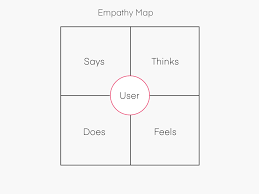Understanding the User: A Guide to Empathy Mapping
Empathy maps are great tools for gathering qualitative data. They can be used to define design challenges and focus features on what customers really want.
To create an empathy map, start by collecting research inputs such as user interviews. Then use sticky notes to record observations about your users in the four key quadrants: Says, Dose, Thinks and Feels.
Gather User Research
Before your team begins to create an empathy map, you’ll want to gather research from your users. This can be done through interviews, surveys, customer outreach or other standard UX research methods.
Once your team has enough data to fill out all four quadrants, they can begin mapping. Encourage them to take notes and write down everything they see, hear, say and do. This will help them get into the mind of your user and understand what they go through when using a product or service.
As they work, participants can cluster similar notes and discuss them. This will help them vocalize their understanding of your user and align on key points that can be included in the empathy map. Once the mapping is complete, you can display it in a common area or distribute it electronically.
Create a Persona
Using empathy maps, you can turn qualitative user research into a persona that represents your target audience. This can help you better understand your customers’ goals and frustrations. For example, if your users are die-hard Starbucks or Dunkin’ Donuts fans, you can use the information to design a product that satisfies those needs.
The first step in creating an empathy map is to gather the data you’ll be analyzing. This can be done through interviews, field studies, diary studies, listening sessions and/or qualitative surveys.
As a team, gather around a whiteboard or flip chart and review the research you’ve collected. Have everyone write down their observations on sticky notes and place them in one of the four essential quadrants of a typical empathy map: Says, Does, Thinks and Feels. Then, cluster the stickies together by similar themes and discuss the findings. This can help you vocalize and align the team on its understanding of your users’ needs.
Conduct a Focus Group
To get a more comprehensive understanding of your user, you can use empathy mapping in conjunction with a focus group. Set up a room where participants can talk freely and share ideas without the fear of being judged by other participants or your company representatives.
During the discussion, be sure to record what your participants say and do. If possible, have a whiteboard and sticky notes available. It’s also important to offer incentives for participation. These can include money, coupons or paid time off.
When you’re done, look over your results and consider what they can tell you about how to improve your product. Try to avoid limiting yourself to the four quadrants of “says,” “thinks,” “does” and “feels.” It’s also helpful to think about pains and gains when creating an empathy map. You can use this information to create features that add value to your users’ lives. For example, a web designer may need to add the ability to build websites quickly.
Create a Map
Empathy maps are designed to be a simple, straightforward tool that captures your product team’s knowledge of a specific persona. While they work best if they’re drawn from actual data, like user interviews, empathy maps can also be constructed out of existing research and stakeholder feedback.
Once the research is gathered, have your team work collaboratively to create an empathy map for one of their personas. The most common form of an empathy map consists of four quadrants: Says, Thinks, Does, and Feels. The team moves through the stickies on the board and clusters similar ones together. They also take into account any themes that appear in each quadrant, as well as any outliers that don’t fit into any cluster.
As a result, your empathy map will become a valuable reference point when designing the ultimate experience for your target persona. The next step will be to use this information to develop a flow chart that will document the actual actions your target person would take from start to finish.
